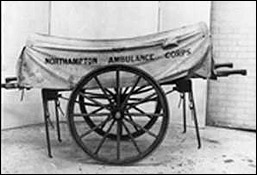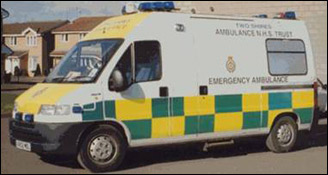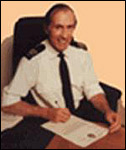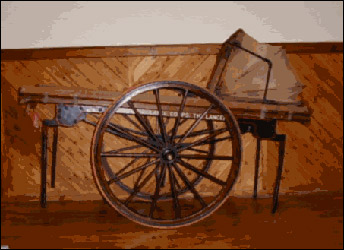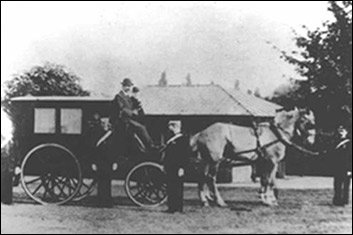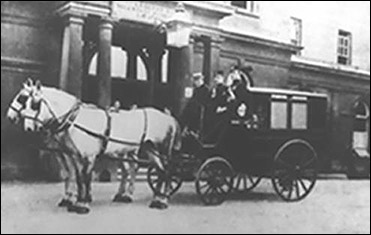|
|||||||||||
| Second edition (based on the First Edition produced by T MacFarlane in 1985), by Alan Pinnell, 2000 |
|||||||||||
|
History of the Ambulance Service
|
|||||||||||
|
|||||||||||
|
The County of Northamptonshire, being a rural County with a population of approximately 540,000 has always been noted for its production of Boot, Shoe & Leather manufacture. But let us look at the needs of providing Patient Health Care within the County.
If we traced back our County history, we would note that the two main Hospitals, Northampton General Hospital to the south and Kettering General Hospital to the north of the County, existed as far back as the Year 1743. Northampton General Hospital first opened in 1743. It was known as the County Infirmary and sited at George Row Northampton. In 1793 it changed to the General Infirmary when the new hospital was built in Billing Road, Northampton and during this early period served as a Voluntary hospital for 205 years until 1903 when it again changed its title to the present Northampton General Hospital. Kettering General Hospital opened in 1897, and though built later than Northampton General Hospital still has considerable history attached to it.
Providing an Ambulance Service during this early period was not as we know it today, although from the year 1886 the needs of providing first aid cover was undertaken by the St John Ambulance Brigade and the British Red Cross Society. From research of records of this early period, members of the public may be enlightened as to the existence of the Ambulance Service within the County of Northamptonshire. Preface In Northamptonshire in the year 1886, industry was at its height with the Boot Shoe and Leather industry being prominent throughout the County. To provide the Population of the County with adequate first aid cover, was duly the responsibility of the Voluntary bodies they, being the St John Ambulance Brigade and the British Red Cross Society who trained members of the public in First aid, and provided Certificates of their skills. If we can look at one area of the County, Northampton, we will be able to see how this Service operated. The early part of the year 1886 saw the first meeting of the Northampton branch of the St John Ambulance Brigade with Northampton being the centre with a covering radius of 8 miles. The objectives of the Brigade were to afford holders of First Aid Certificates to meet and discuss Ambulance and Nursing practices. To render first aid to the sick and injured on public occasions, with the sanction of the police and public authorities and finally to provide a body of men and women trained to act not only in nursing the sick but also in Ambulance transport duties. The members trained came from various areas e.g. The County and Borough Constabulary, The Gas Board, Midland Railway Company, Phipps Brewery, The Fire Brigade Volunteers and indeed many more. It was through these meetings that interest grew in forming a Corps of members able to cover public events and functions. Wheeled Litter‘s 1886 - 1888 1887 – 1888 Formation of Northampton Ambulance Corps
Description of an Ambulance journey from Wellingborough to Northampton Infirmary Dated 1887 Using the wheeled litter around the year 1887. Two men would volunteer for this mission, obtaining the litter from its depot in Earls Barton. Having picked up the patient from Wellingborough they would make their way to Midland Road Railway Station, placing the litter and the patient onto the guard's wagon and proceed to Northampton St John Street Station they would continue to push the litter to the Northampton Infirmary. Having discharged the patient in the care of the Matron, they would make the return journey replacing the litter finally back to the depot.
Around the same time as the Wheeled Litters were used in Northampton and Wellingborough a similar Litter was used by the RUSHDEN AMBULANCE CORPS. The patient was picked up at their home in Rushden and pushed to Irchester (Station Road), Ditchford Lane, or Irthlingborough Railway Station. Then placing the litter and the patient onto the guard's wagon proceeded to Wellingborough (Midland Road) Railway Station and then on to Northampton (St John Street) Railway Station, they would continue to push the litter to the Northampton Infirmary. Having discharged the patient in the care of the Matron, they would make the return journey replacing the litter finally back to the depot in Rushden. In 1893 when the Midland Railway Company opened the new railway line from Irchester to Rushden and Higham Ferrers, it was then possible to pick up the patient from their home in Rushden and taken to the new Railway Station in Station Approach. Their journey continued via Wellingborough as before. This Litter in the year 2000 is in the custody of Rushden St John Ambulance Brigade. Horse Drawn Ambulances 1888 – 1912 1888 - 1890 After looking at the problems with regard to the miles covered by wheeled litter, the Northampton Ambulance Corps on 11 November 1888, decided to purchase a horse drawn Ambulance. The tender to supply this vehicle given to Messers A F Mulliners the noted Carriage Cab manufacturer sited at 73/81 Bridge Street Northampton. The cost of this Ambulance wagon was £48.00 plus £6.10s.0d. for the rubber tyres. Funds for the Horse drawn Ambulance were obtained £20.00 from the Corps along with 1 guinea each from 27 Parishes and the remainder from donated funds. It is interesting to note that in 1900 solid rubber tyres at a cost of £24.00 replaced the pneumatic tyres. Having built the Ambulance wagon, the next step for the Corps was the provision of horses for its conveyance. This was also put out to tender and a Mr S Frisby – Carriage and Cab Proprietor - had the Ambulance and Fire contract to supply horses. His premises were located at No. 29 Market Square within the Peacock Hotel area. It is interesting to note that his business took priority with regard to the use of horses, with his funerals and weddings taking prominent place, followed by his taxi hire and finally the Fire and Ambulance wagons.
1890 - 1912 The following extract was taken from Northampton first directory dated 1893/1894 by kind permission of Lea & Co. Ltd. "A list of Ambulance Volunteers, is to be found in Public buildings and Telephone offices in the town." The Borough Police Constables are holders of Ambulance certificates. For the removal of sick persons by means of appliances of the Corps, application should be made to the Invalid Transport Service, 1 Mercers Row, Northampton or any of the transport staff. Charges for Horse Ambulance = 10s.0d or 3s.0d per mile Charges for Wheeled litters = 2s.6d. or 2.0d. per mile Reduced charges for persons holding Infirmary letters or leaving the Infirmary. Accident cases removed free of charge." Before we move on to the year 1912, if we could picture the horse Ambulance in use in and around Northampton, the crew would be given a lunch pack if their journey took them out to a distance of 8 miles. For example the distance from Northampton to Weedon in the south and from Northampton to Earls Barton in the north of the County. We should remember that at this time horse buses and cabs were in use along with many other forms of horse driven commercial transport. In the year 1881 horse buses were replaced by horse trams thus quite a range of transport available and possibly more accidents happening due to this increase in transport.
|
|||||||||||
|
Special thanks to John Harley and John Drage.
|
|||||||||||
